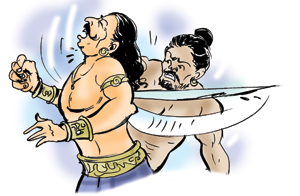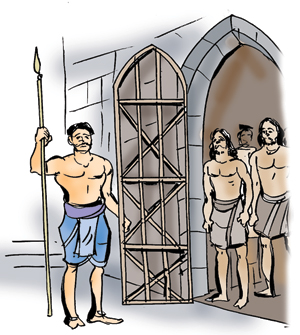1. The Kandyan Kingdom could not annexe the Four Korales. King Buwanekabahu succeeded in keeping it under his
control. Yet, Sena Sammatha Vickramabahu came to power in the Kandyan Kingdom. This prince carried on an
independent rule, for at least 37 years. Some
scholars say that this is proved by inscriptional
evidence. However, there is also evidence to say that there was constant unrest in the Sinhala areas.
2. This meant that the king had to intervene very often, to suppress this unrest. This gave a good opportunity to Aryachakravarti, who was overseas, to recapture the kingdom. According to the ancient stories in Jaffna, 'Kanakasuriyan' had come back, after 17 years, killed Vijayabahu who was
occupying the throne and got back the throne. But the records of the Sinhala people give a
different version. According to these records, Jaffna too had been under Sinhala supremacy from the time of King Parakramabahu VI.
3. Once Prince Sapumal captured Jaffna, it was ruled for 20 long years under King Parakramabahu VI. Even after Buwanekabahu became king, Jaffna was kept under the Kotte Kingdom. In certain proclamations made while in Jaffna, it is stated that Nallur Kovil was built by King Buwanekabahu. In a song of praise sung at the kovil, even today, his name came as Siri Sangabodhi Buwanekabahu.
4. As long as King Parakramabahu was
ruling, Prince Sapumal could not use this name. He would have used it after he became king as Buwanekabahu. In later years however, this
kingdom was divided into three. The supremacy of the Kotte Kingdom was only nominal. In his later years, King Buwanekabahu got
friendly with Sri Vardana Pathiraja and released him from prison.
5. He entrusted him with the safety of the prince who was the heir to the throne. It had been another Parakramabahu. According to the Rajavaliya he was Buwanekabahu's son. The Portuguese historian Kuto too holds this theory.
However, he adds another part to his name and says it was Prince 'Chaipura Bandara.' His mother had been a princess from Kandy. In the year
1479 A. D., King Buwanekabahu VI passed away.
6. He was succeeded by Prince Parakramabahu, who was also known as Chaipura Bandara. He became king as Pandita Parakramabahu VII. When Prince Ambulugala, who was in the Four Korales, got to know this, he got angry and came to Kotte with an army. He set up camp at Siyane Korale. From there he proceeded to Kelaniya. Fighting broke out there. He lost in the battle and went to the
village named Heenkenda.
7. Another battle was fought there. In the fighting both Sri Vardana Pathiraja and the leader of Kurugama, were killed. Prince Ambulugala marched to the capital city, in a victorious manner. The king whose hopes were shattered, got the women of the harem killed, to avoid them falling into the hands of the enemy. He opened the doors of the palace and with three loyal leaders, waited to see what fate would befall them. For this he had immense patience.
8. In the dead of night, Prince Ambulugala entered the palace and killed the helpless king. Thereafter, he assumed power and was crowned as Veera Parakramabahu VIII in 1489 AD. This King Veera Parakramabahu VIII is supposed to have
suppressed a rebellion in the Kandyan Kingdom.
|



